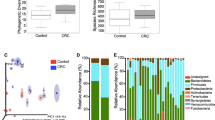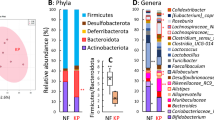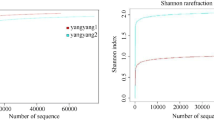Abstract
Rapidly evolving sequencing technologies have enabled efficient sequencing of complex genomes and metagenomes. Here, we have presented our metagenomic analysis of rat faeces isolated DNA, sequenced using long-read sequencing technology. The microbiome changes in the rat faeces after sixteen weeks of prolonged administration of subcutaneous 1,2 dimethylhydrazine to induce colon carcinogenesis and oral carotenoid-rich whole-cell lyophilised Dunaliella salina supplement. The faecal pellets were aseptically collected, and DNA was isolated and sequenced subsequently. The post-sequencing analysis revealed that the rat gut microbiome is highly complex and diverse. There was a significant difference between the microbiome of rats that received Dunaliella salina supplement in comparison with rats treated with 1,2 dimethylhydrazine and control rats. We observed the dominance of Bacteroidetes over Firmicutes in both cases of administration. The dominance was notably contributed by individuals like B. vulgatus, B. dorei, B. fragilis, P. ruminicola, and P. copri. The presence of protozoans like Trypanosoma, Trichomonas, and Leishmania was also identified among other commensal eukaryotes. Moreover, there was an abundant presence of bacteriophages targeting probiotic organisms like Lactobacillus among the identified DNA viruses.



Similar content being viewed by others
Availability of Data
The raw sequence reads of this metagenome project are submitted at the Sequence Read Archive (SRA) and can be accessed using Accession Number PRJNA622417.
Abbreviations
- DSLP:
-
Dunaliella salina Lyophilised powder
- DMH:
-
Dimethyl hydrazine
- MG RAST:
-
Metagenomics rapid annotation based on subsystems technology
- GUS:
-
Glucuronidase
References
Shin J, Lee S, Go MJ et al (2016) Analysis of the mouse gut microbiome using full-length 16S rRNA amplicon sequencing. Sci Rep 6:1–10. https://doi.org/10.1038/srep29681
Matturro B, Mascolo G, Rossetti S (2020) Microbiome changes and oxidative capability of an anaerobic PCB dechlorinating enrichment culture after oxygen exposure. N Biotechnol 56:96–102. https://doi.org/10.1016/j.nbt.2019.12.004
Likhachev A, Anisimov V, Parvanova L, Pozharisski K (1985) Effect of exogenous β-glucuronidase on the carcinogenicity of 1,2-dimethylhydrazine in rats: evidence that carcinogenic intermediates form conjugates and act through their subsequent enzymatic release. Carcinogenesis 6:679–681. https://doi.org/10.1093/carcin/6.5.679
Lyu Y, Wu L, Wang F et al (2018) Carotenoid supplementation and retinoic acid in immunoglobulin A regulation of the gut microbiota dysbiosis. Exp Biol Med 243:613–620. https://doi.org/10.1177/1535370218763760
Srinivasan R, Chaitanyakumar A, Mageswari A, Gomathi A, Kumar JGSP, Jayasindu M et al (2017) Oral administration of lyophilized Dunaliella salina, a carotenoid-rich marine alga, reduces tumor progression in mammary cancer induced rats. https://doi.org/10.1039/c7fo01328k
Gomathinayagam S, Gothandam KM (2020) Amelioration of doxorubicininduced cardiotoxicity by oral lyophilized Dunaliella salina supplement in a female Wistar rat model with active estrous cycle and surgical menopause. Phcog Mag 2020:16. https://doi.org/10.4103/pm.pm_52_20
Emerich S, Fiala (1973) Investigations into the metabolism and mode of action of the colon carcinogen 1, 2-dimethylhydrazine. J Biophys Biochem Cytol 219:214–219
Reddy BS, Weisburger JH, Narisawa T, Wynder EL (1974) Colon carcinogenesis in germ-free rats with 1,-dimethylhydrazine and N-methyl-N’-nitro-N-nitrosoguanidine. Cancer Res 34:2368–2372
Goldin BR, Gorbach SL (1981) Effect of antibiotics on incidence of rat intestinal tumors induced by 1, 2-dimethylhydrazine dihydrochloride. J Natl Cancer Inst 67:877–880. https://doi.org/10.1093/jnci/67.4.877
Ericsson AC, Gagliardi J, Bouhan D et al (2018) The influence of caging, bedding, and diet on the composition of the microbiota in different regions of the mouse gut. Sci Rep 8:1–13. https://doi.org/10.1038/s41598-018-21986-7
Randall DW, Kieswich J, Swann J et al (2019) Batch effect exerts a bigger influence on the rat urinary metabolome and gut microbiota than uraemia: a cautionary tale. Microbiome 7:1–10. https://doi.org/10.1186/s40168-019-0738-y
Sheahan T, Hakstol R, Kailasam S et al (2019) Rapid metagenomics analysis of EMS vehicles for monitoring pathogen load using nanopore DNA sequencing. PLoS ONE 14:1–20. https://doi.org/10.1371/journal.pone.0219961
Liu X, Tan J, Yang H et al (2019) Characterization of skin microbiome in tinea pedis. Indian J Microbiol 59:422–427. https://doi.org/10.1007/s12088-019-00816-y
Ma Q, Li Y, Wang J et al (2020) Investigation of gut microbiome changes in type 1 diabetic mellitus rats based on high-throughput sequencing. Biomed Pharmacother 124:109873. https://doi.org/10.1016/j.biopha.2020.109873
Cani PD (2018) Human gut microbiome: hopes, threats and promises. Gut 67:1716–1725. https://doi.org/10.1136/gutjnl-2018-316723
González-Prendes R, Pena RN, Solé E et al (2019) Modulatory effect of protein and carotene dietary levels on pig gut microbiota. Sci Rep 9:1–9. https://doi.org/10.1038/s41598-019-51136-6
Wiese M, Bashmakov Y, Chalyk N et al (2019) Prebiotic effect of lycopene and dark chocolate on gut microbiome with systemic changes in liver metabolism, skeletal muscles and skin in moderately obese persons. Biomed Res Int. https://doi.org/10.1155/2019/4625279
Manju V, Nalini N (2007) Protective role of luteolin in 1,2-dimethylhydrazine induced experimental colon carcinogenesis. Cell Biochem Funct 25:189–194. https://doi.org/10.1002/cbf.1305
Funding
This research did not receive any specific grant from funding agencies in the public, commercial, or not-for-profit sectors.
Author information
Authors and Affiliations
Corresponding author
Ethics declarations
Conflict of interest
The authors declare no conflicts of interest.
Additional information
Publisher's Note
Springer Nature remains neutral with regard to jurisdictional claims in published maps and institutional affiliations.
Electronic supplementary material
Below is the link to the electronic supplementary material.
Rights and permissions
About this article
Cite this article
Gomathinayagam, S., Kodiveri Muthukaliannan, G. Metagenomic Analysis of the Faecal Microbiome of Rats with 1, 2-Dimethylhydrazine Induced Colon Cancer and Prophylactic Whole-Cell Carotenoid Intervention. Indian J Microbiol 61, 38–44 (2021). https://doi.org/10.1007/s12088-020-00909-z
Received:
Accepted:
Published:
Issue Date:
DOI: https://doi.org/10.1007/s12088-020-00909-z




